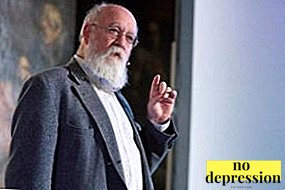Cognitive science is relatively new field of science, having a highly specialized focus.
It brings together specialists in various fields. Currently actively developing and accumulating knowledge.
Concept and brief history

What is cognitive science?
Cognitive science in the broad sense of the word means a set of scientific disciplines and research, studying intelligence and ways of storing, acquiring, changing and using knowledge.
The narrow definition was given by Michael Eysenck. According to Aysenck, cognitive science is an interdisciplinary study of the application and acquisition of knowledge.
There is another definition according to which cognitive science is interdisciplinary complex of scientific fieldswho study the knowledge and higher forms of mental activity and thought processes.
Unites in itself research results in the following sciences:
- psychology;
- philosophy;
- anthropology;
- theory of knowledge;
- neurophysiology;
- artificial intelligence theory.
Cognitive studies arose as a result of the opposition of the theory of behaviorism proposed by the American psychologist John Watson.
Watson stated that only behavior should be studied from a scientific point of view, consciousness can not be the subject of interest of science.

Since the beginning of the 1950s, Watson’s theory has lost the title of the only true one.
John miller suggested that parts of the information are encoded and decoded in the deep limits of the mind.
Later scientists John McCarthy, Herbert Simon and others set up an area of science called artificial intelligence.
The term cognitive science was first used. Christopher Longue-Higgins in 1973.
Famous Cognitivists
There are a certain number of people in the world who have dedicated themselves to the study of cognitive science, and they are rightly recognized by experts in this field.
 Daniel Dennett - American philosopher and cognitive. During his long scientific activity he wrote many scientific works on consciousness, free will. In particular, he claims that will and consciousness are an illusion, they are the result of physiological processes occurring in the brain.
Daniel Dennett - American philosopher and cognitive. During his long scientific activity he wrote many scientific works on consciousness, free will. In particular, he claims that will and consciousness are an illusion, they are the result of physiological processes occurring in the brain.- Stephen Pinker - American scientist, psycholinguist, psychologist. Pinker developed his theory of language learning. He wrote the well-known scientific book “Language as an Instinct,” in which he popularized the works of Noam Chomsky.
- George lakoff - American linguist, expert in the field of linguistics. Gained fame as the creator of generating semantics.
- Jerry fodor - American philosopher, experimenter in the field of psycholinguistics. Developed a theory about the language of thought.
- David chalmers - Australian philosopher and cognitive. The field of specialization involves the philosophy of mind and language. Chalmers formulated the concept of the problem of consciousness.
Classical methods based on
The basis of cognitive science laid two classical methods.
The first method is called symbolism. The main idea of the method is the similarity between human mental activity and computer thinking. The computer has a central processor in which all incoming information is processed. Man has a similar structure.

The second method is called connectionism. Completely contradicts the first method.
The thinking of a person cannot be compared with the thinking of a computer processor, because this neuroscience data on brain activity disproves this statement.
Artificial neural networks can stimulate human thinking.
Application of knowledge in practice
Knowledge of cognitive science widely used in practice.
Cognitivists can help people with problems or dysfunctions of the brain. An individual treatment program is being developed, and as a result, natural processes in the brain are restored in humans.
Cognitive science allows you to create the right methodology for children to learn languages or other subjects that require the active work of the brain.
Website developers can take advantage of cognitive science. When placing advertisements for the site owner, it is important that the ad is immediately noticed by a person, and he would be interested in the proposed option.
For this purpose, you need to understand what kind of organization has human attention and perception, explore eye movement.

The cognitive science knows the answers to these questions and it helps the site owners. place an advertisement for yourself.
According to the same principle, customers of advertising on television work.
Ideally, you can prevent the development of diseases, if scientists understand the mechanism of how to send such signals to the brain so that it does what the body needs for normal functioning.
Methods of modern cognitive science
Cognitive science is an interdisciplinary science, so research methods from psychology, neuroscience, artificial intelligence theory and others are applied.
- Behavioral experiments. To understand the structure of behavior you need to study the behavior itself. Techniques such as reaction time are used, which determines the time difference between the presentation of the stimulus and the receipt of the answer to it, psychophysical responses, and threshold differences for colors, tones, and structures. An interesting type of behavioral experiment is eye tracking.
- Brain mapping Includes analysis activities within the brain, allowing you to perform various tasks. Allows you to link the behavior and functions of the brain to understand the process of information processing.
 Brain imaging is carried out in the form of computed tomography, electroencephalography, magnetic resonance imaging, magnetic encephalography, using such tools you can understand the activity of neurons, to identify which areas of the brain respond to information faster.
Brain imaging is carried out in the form of computed tomography, electroencephalography, magnetic resonance imaging, magnetic encephalography, using such tools you can understand the activity of neurons, to identify which areas of the brain respond to information faster.
Eye movement reflects decision making while thinking about a problem. By controlling the movement of the eyes, scientists manage to study what information is being processed at a stated time.
The brain mapping group includes optical mapping. Infrared transmitters and receivers are used. Safe technology allows studying the brain not only in adults, but also in babies.
- Computational modeling. Requires a mathematical formulation of the problem. Allows you to understand the functional organization of the cognitive phenomenon.
- Of less popular methods stand out the dynamic theory of systems, neuro-symbolic integration and Bayesian models, methods of direct brain stimulation, post-mortem studies.
Cognitive science is a young science with a great future. Scientists are doing their best for application of accumulated knowledge in practiceand ordinary people watch with interest the rapid development of the cognitive sciences and acquire new knowledge about cognition, thought processes.
Lecture M. V. Falikman "Modern cognitive science: inside and outside the skull box":

 Daniel Dennett - American philosopher and cognitive. During his long scientific activity he wrote many scientific works on consciousness, free will. In particular, he claims that will and consciousness are an illusion, they are the result of physiological processes occurring in the brain.
Daniel Dennett - American philosopher and cognitive. During his long scientific activity he wrote many scientific works on consciousness, free will. In particular, he claims that will and consciousness are an illusion, they are the result of physiological processes occurring in the brain. Brain imaging is carried out in the form of computed tomography, electroencephalography, magnetic resonance imaging, magnetic encephalography, using such tools you can understand the activity of neurons, to identify which areas of the brain respond to information faster.
Brain imaging is carried out in the form of computed tomography, electroencephalography, magnetic resonance imaging, magnetic encephalography, using such tools you can understand the activity of neurons, to identify which areas of the brain respond to information faster.

